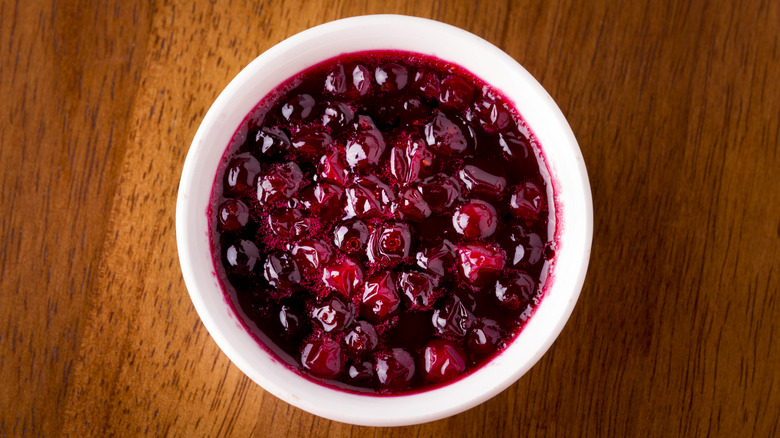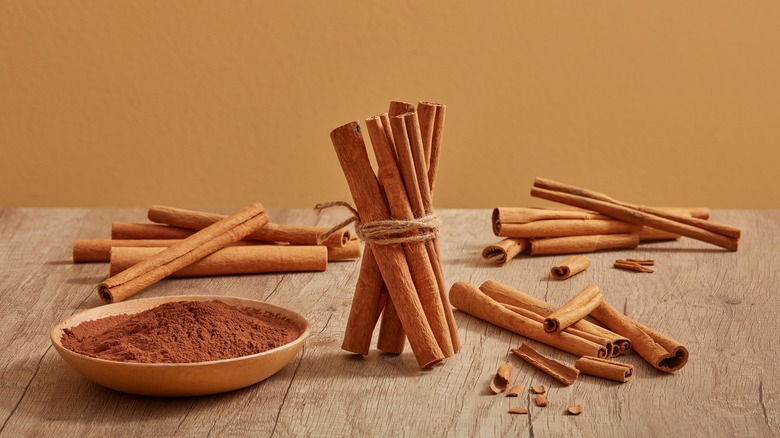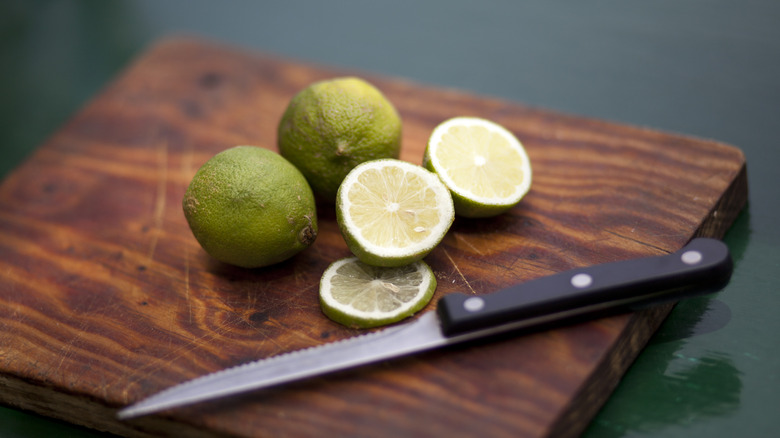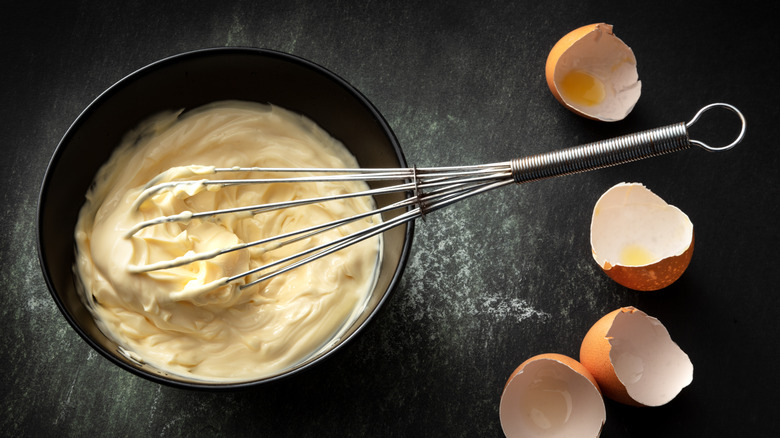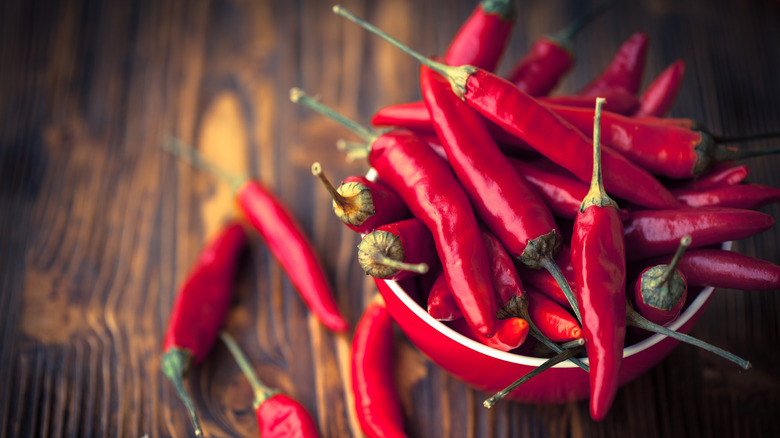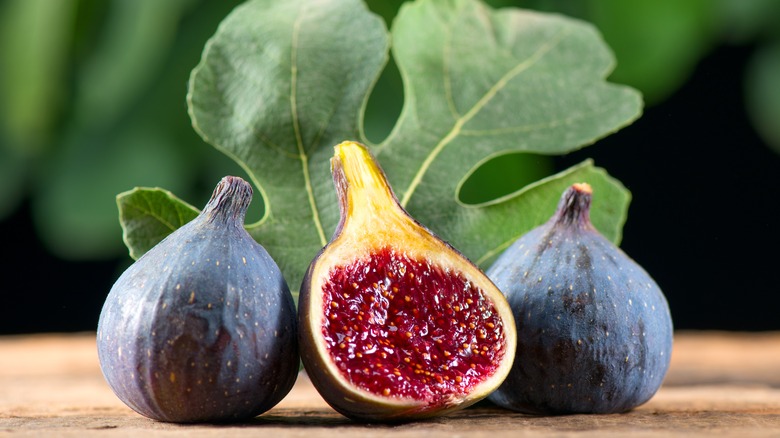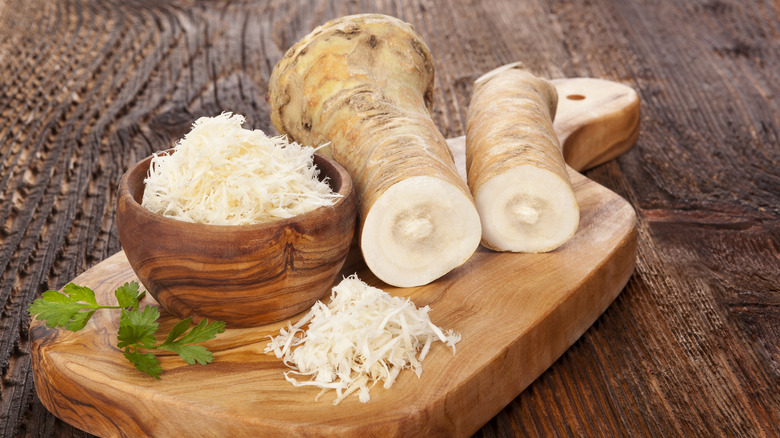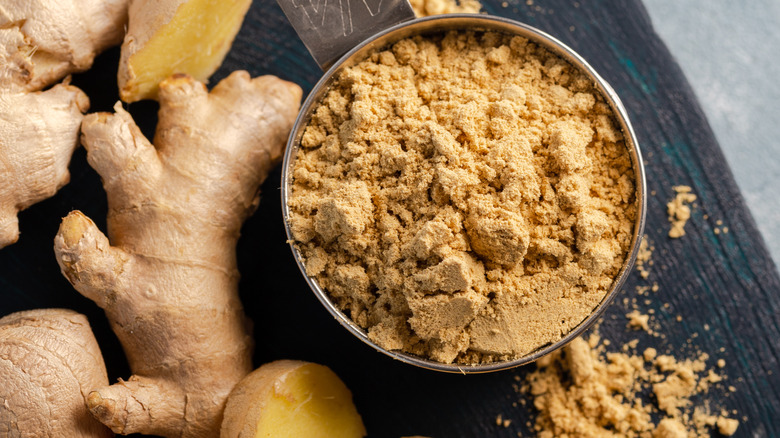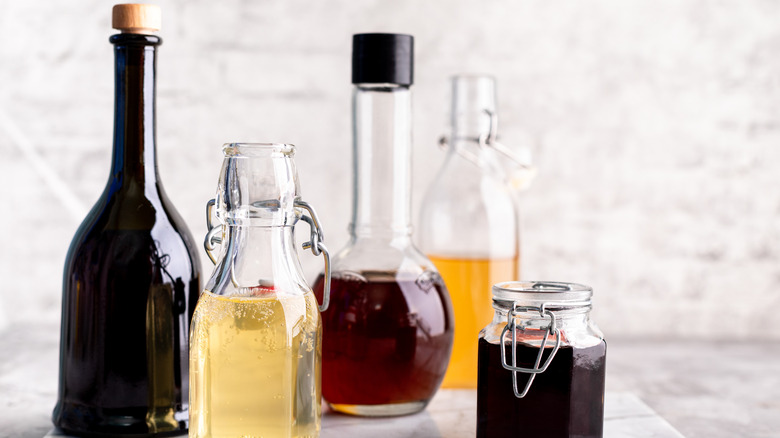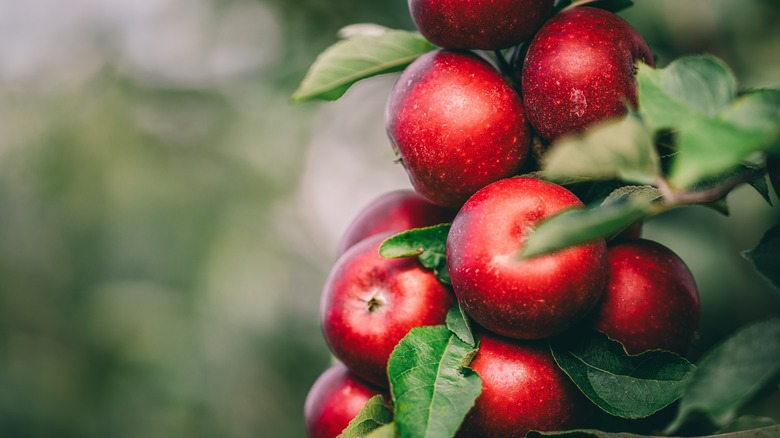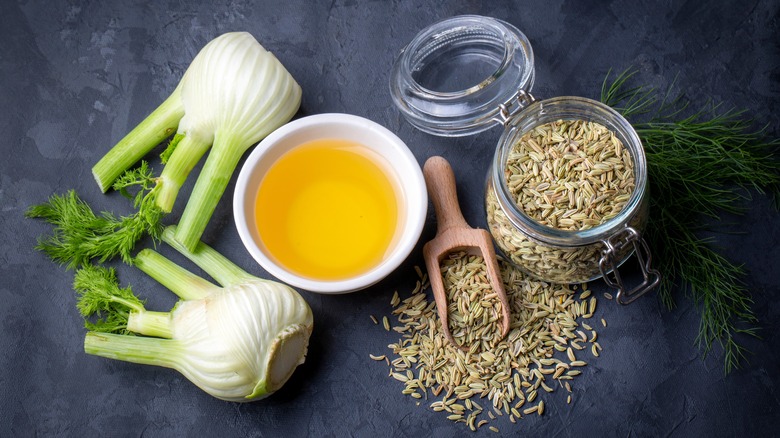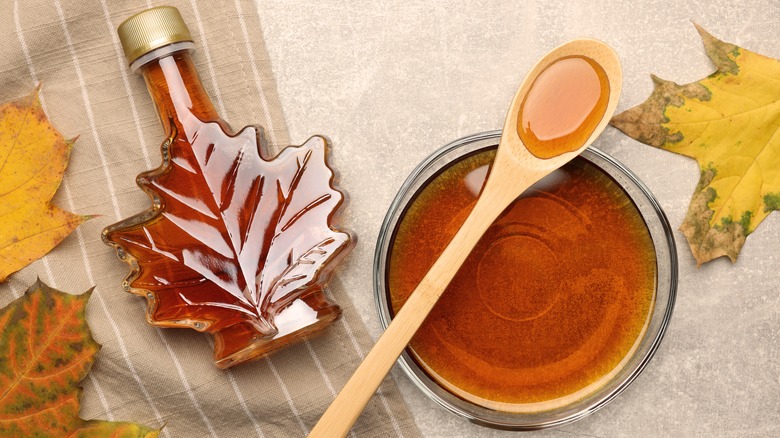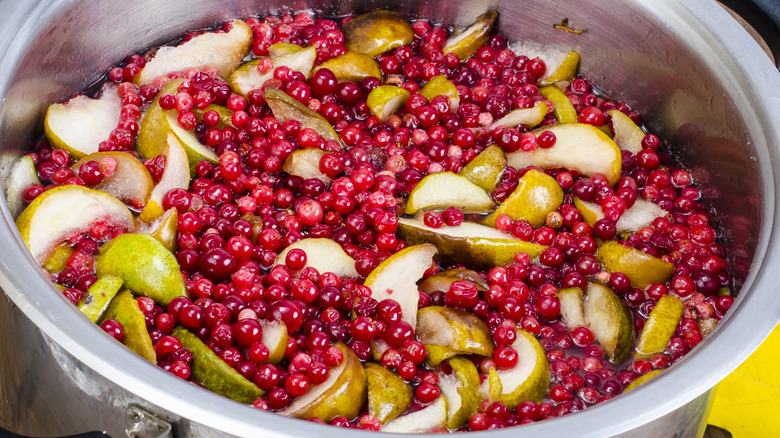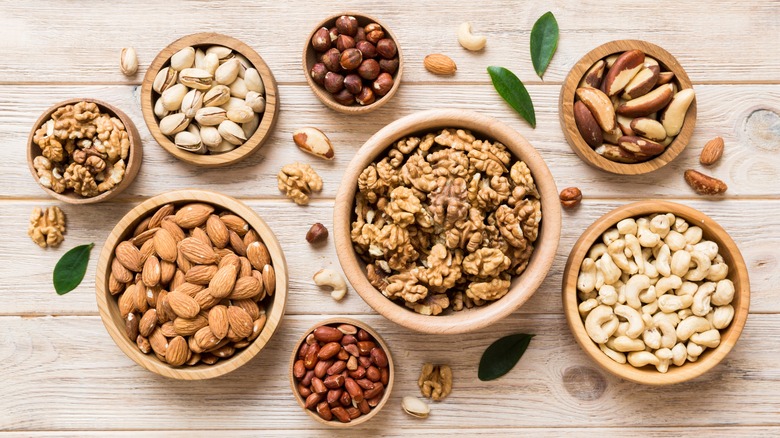14 Delicious Add-Ins To Make Cranberry Sauce The Star Of Your Meal
No Thanksgiving is complete without cranberry sauce, and yet, the condiment often languishes uneaten at the end of the meal. You might even have a stray Tupperware of it in your fridge from last year. The bright red sauce, with its perfect balance of tartness and sweetness, provides the ideal contrast for the savory — and let's face it — dry turkey and the abundance of creamy side dishes, but they often overshadow it. Now is as good a time as any to change that.
Cranberries are a versatile fruit that can be paired with a wide range of unexpected ingredients, whether sweet, savory, spicy, or alcoholic. From citrus and spices to nuts and herbs, the possibilities are endless. By incorporating new textures and flavors, you can transform the humble cranberry sauce into a show-stopping dish that will have your guests coming back for seconds. And the best part? These simple additions are so straightforward that they won't take up precious cooking time during a holiday when you need all the hands and burners you can get. We've rounded up some of the yummiest add-ins that will not only have your guests savoring every last spoonful, but leave them wanting more. Whether you prefer a chunky, homemade sauce or the smooth, canned variety, we've got you covered. Get ready to discover the perfect balance between adventurousness and tradition that will make cranberry sauce the star of Thanksgiving.
1. Cinnamon
Sometimes, it only takes a pinch of an ingredient to make all the difference. Cinnamon is a deceptively simple addition to cranberry sauce that changes the flavor entirely. Most recipes capitalize on the sweet-tart taste of the red berries, but it can be overpowering for some, especially children who might not like the sensation of all that acid. While cinnamon doesn't remove the tartness, it does offer a counterbalance, introducing a familiar warming spiciness with a hint of sweetness.
Our recipe for cinnamon-infused cranberry sauce also includes orange juice, which is such a common addition that its inclusion almost goes without saying. Orange juice has a similar sweet-tart profile as cranberries, but with a much greater emphasis on sweetness. Its overall effect is to dilute the tartness in the cranberries without altering their flavor. With just half a teaspoon of cinnamon, the tart fruitiness of the cranberries and orange juice is transformed into a dish that tastes like fall, and will remind you of the pumpkin pie that's waiting on the dessert table.
2. Lime
Lime might seem like a tricky and even ill-advised addition to cranberry sauce. It's about as sour as citrus fruits get, and combined with the mouth-puckering tartness of cranberries, it could be the last straw for people who are already on the fence about the condiment. However, lime has a distinctive flavor that sets it apart from the tartness of the cranberries. You can use as little as a single tablespoon, though a ¼ cup of lime juice is the perfect amount to bring a refreshing, zesty kick to traditional cranberry sauce and an additional hint of floral sweetness.
One of the biggest benefits of adding lime is its acidity. Far from being a detractor, it helps balance the sweetness of the added sugar and cut through the greasiness of all the holiday comfort foods. Lime also injects a citrusy freshness that orange juice cannot do on its own. Think of it as a garnish for the cranberries rather than a rival. It introduces a new flavor without overpowering the classic dish, and with enough sugar, it won't make the condiment too acidic. For a colorful alternative to lime juice, use the zest. It adds the same bright flavor, but provides a festive touch of green to the ruby-red sauce.
3. Mayonnaise
Maybe you or one of your loved ones just doesn't like cranberry sauce in its traditional form. Its tartness can be off-putting for some, while for others, the idea of putting something sweet on savory food feels all wrong. To this, we say: try cranberry mayonnaise. Yes, it's still tart and sweet, but the creamy white condiment takes the edge off of both.
Instead of adding an ingredient to cranberry sauce, this variation flips the script and turns cranberry sauce into the addition. Start with a jar of mayonnaise and some cranberry sauce (canned or handmade), and combine them into one fully incorporated condiment. There is something nostalgic and a little retro about this combination. It's reminiscent of a holiday gathering from the '70s when dishes like ambrosia salad and fondue ruled the meal. If you have picky eaters in your ranks, this take on cranberry sauce might win them over, and it will probably charm fans of the traditional sauce, too. On top of this, it makes a mouth-watering sandwich spread year-round.
4. Chilis
The main purpose of cranberry sauce is to act as a palate cleanser. Its tartness cuts through the fattiness that dominates Thanksgiving food and resets your taste buds between bites. Given its role as a gastronomical reset button, why not shock your palate with even more flavor by adding chilis? They'll leave no one in any doubt that this year's recipe is in a league of its own.
For the quickest, most neutral-tasting option, choose chili flakes. You probably have some in your pantry already, and their spiciness will add as much heat as you want without much additional flavor. If you want a little more complexity, you can choose from a wide range of fresh peppers, including jalapeños, poblanos, or serranos. You could even add a smoky kick with chipotle peppers. Mince them finely and let them cook down with the cranberries where their natural oils and heat will mingle with the tart berries. A third option is to add chili powder. A little goes a long way, so start with a pinch and work your way up. A dash of cayenne is enough to surprise and delight your guests without overwhelming them.
5. Figs
Many unexpected ingredients take cranberry sauce to the next level, but one of the best options is surprisingly simple: figs. This sweet, teardrop-shaped fruit is often passed over in baking and cooking, but its perfumey, honey-like sweetness cannot be mimicked with anything else. This variation of cranberry sauce appeals to those who prefer jam over chutney. It's sweet and mild, but unmistakably different from traditional cranberry sauce.
In addition to their sweetness, figs provide textural variation as well. If you use dried figs, you'll have a pleasing contrast between their slight chewiness and the melt-in-your-mouth texture of stewed cranberries. Their seeds also provide an added crunch. For the best result, scale back on the sugar if you're adding figs to a standard cranberry sauce recipe. If you want to make it boozy, dessert wine such as port is a delicious addition, while spices like cloves and nutmeg will enhance the festive flavor. You can also take things in an unexpected direction by adding a savory edge. Balsamic vinegar, caramelized onion, and red pepper all pair well with figs and provide an even more surprising twist on a classic recipe.
6. Horseradish
Horseradish is not known for its universal appeal. In fact, many people avoid it like soggy fries. The root vegetable has a similar peppery flavor as wasabi, a fellow member of the Brassica family, and it's often found in Bloody Marys and cocktail sauce. It is not often associated with sweet recipes due to its pungent, mustardy spiciness. The saying goes that two wrongs don't make a right, but when it comes to cooking, sometimes two incongruous and even polarizing ingredients can come together in perfect harmony. Enter, cranberry relish with horseradish. The combination was made famous (or infamous) by veteran NPR reporter Susan Stamberg, who has brought it to listeners every year since the '70s, but there are many variations that you can explore as well.
The basic formula includes cranberries, horseradish (a couple of tablespoons will do), onion, sugar, and sour cream. Sound icky? We can't disagree. All we can say is, it just works. It's tangy, sweet, creamy, and has a spicy kick from the horseradish. It solves the dilemma of whether to categorize cranberry sauce as a condiment or a side dish because it only works in small doses. Eating it on its own is not recommended, but slather a tablespoon of it on some turkey and you won't believe how delicious it tastes.
7. Ginger
Many holiday recipes include ginger, and for good reason: it's a fiery, warming ingredient that turns even the most bland dish into a comfort food. Whether you're making a savory soup, fending off a cold with freshly brewed tea, or baking a dessert, ginger will elevate the recipe to something flavorful, fragrant, and a little spicy. Cranberry sauce is no different. The peppery, faintly sweet flavor of ginger pairs well with the tartness of the cranberries, creating a harmonious blend that is festive and warming.
There are several ways to incorporate ginger into the classic holiday condiment. Ground ginger is the easiest option. Start with half a teaspoon and add more to taste. It has a more subtle flavor than fresh ginger, but its presence will not go unnoticed. Fresh ginger brings a peppery heat that will give the cranberries a run for their money. You can also use crystalized or candied ginger. This adds sugar, texture, and heat to the sauce while also changing its appearance slightly. If you're only looking for a subtle flavor enhancement, ground ginger is the best option. For a fiery, unmistakable twist on classic cranberry sauce, fresh ginger will have the greatest impact. And if you want a sweet version that still carries the warmth of ginger, crystallized ginger offers a festive and visually appealing result.
8. Vinegar
Vinegar isn't the kind of ingredient that makes mouths water. On its own, it's more likely to make you grimace. When paired with other ingredients, however, it becomes a miraculous secret weapon. Pickled cranberries are surprisingly similar to regular cranberry sauce, just ... better. With brighter flavors and a bite of acidity at the end, it is the perfect accompaniment to turkey and all the salty side dishes on the Thanksgiving table.
Far from being savory, this concoction retains the sugary sweetness of cranberry sauce, especially if you add cinnamon, allspice, and cloves. Any type of vinegar will work, but apple cider vinegar lends another layer of autumnal flavor. As a rule of thumb, 3 cups of vinegar to two 12-ounce bags of cranberries is about how much you need, and make sure to cut down on the simmering time to allow the cranberries to hold some of their shape. If you have time, let the mixture sit in the vinegar liquid for at least 24 hours to let the flavor fully develop.
In the unlikely event that you have any sauce left over at the end of the meal, don't let anyone walk away with it because this creation is the gift that keeps on giving. Use the liquid in cocktails or sparkling water (it tastes like gourmet kombucha), or use it as a chutney with cheese and crackers. You can even turn it into a festive topping for ice cream or pumpkin pie.
9. Apples
Apples are inescapable during the fall and winter. Whether you're baking an apple pie, biting into a candied apple, or going old school by bobbing for apples, they are a huge part of the holidays, and we wouldn't wish for anything different. There are, however, ways to jazz things up instead of falling back on the same familiar recipes. One option is to turn your standard cranberry sauce into an apple showcase. Apples make an ideal pairing for cranberries because, like oranges, they are sweet and sour, leaning more toward sweetness, and their flavor profile complements the cranberries while dialing back their tartness.
There are multiple options for incorporating apples into your recipe. One way is to dice them into cranberry-sized pieces and stew them with the rest of the ingredients. Another is to make a relish, pulsing fresh cranberries and apples in a food processor with sugar and orange juice. This will give you a sharper-tasting dish that will offer a pleasing contrast with the rest of the meal. If you want tart cranberry sauce, opt for Granny Smith or Pink Lady apples. If you want something on the sweeter side, pick Galas or Fujis.
10. Fennel
Of all the flavor-packed ingredients you can add to cranberry sauce, fennel is not an obvious choice. It's a vegetable, for one thing, with a white, crunchy bulb, and green, celery-like stalks. It also has the divisive flavor of licorice, which most people either love or hate. When added to cranberry sauce, however, the ingredient offers a refreshing and unexpected counterpoint to the sugary tartness of the dish. You can use it to enhance the sweetness, adding star anise, ginger, cloves, and plenty of sugar, or use it as a jumping-off point for a more savory take on the condiment with the addition of onion and salt.
Because multiple parts of the fennel plant can be used, it's important to determine which will work best with your recipe. The bulb will add a crunchy texture and a bright, refreshing flavor. Make sure to sauté it before adding it to the simmering cranberries to avoid toughness. The seeds are easier to incorporate but should be used sparingly. Half of a teaspoon is plenty. Toasting them in the pan before adding the rest of the ingredients will ensure that they release all their flavor.
11. Maple Syrup
It's tempting to add maple syrup to every holiday meal. In contrast to refined sugars, it offers a rich, earthy flavor, complementing the tartness of the berries and creating a more sophisticated take on the classic sauce. It's also one of the easiest additions you can make. Simply swap syrup for the prescribed sugar and you'll have a unique, autumnal variation on a familiar favorite.
By adding maple syrup, you can forgo other flavorings. The sugary sap has hints of vanilla and spices all on its own, providing the sauce with plenty of flavor. Alternatively, you can capitalize on its complexity by adding complementary flavors such as nutmeg, cinnamon, and even a dash of brandy. As with most cranberry sauce recipes, this variation benefits from a generous portion of orange juice to enhance the sweetness and add a citrusy element. Make sure you're using pure maple syrup rather than maple-flavored pancake syrup. It's more expensive, but its depth and complexity of flavor are worth it.
12. Pears
Of all the fruits and vegetables that are in season during the winter, pears are the most criminally overlooked. Although their quality is harder to judge than, say, strawberries or bananas, a perfectly ripe, sweet pear is nothing short of heavenly. Sugary, aromatic, and floral, pears are one of the best additions to cranberry sauce. Although their flavor can be subtle in comparison to the tart berries, the right ratio will allow them to shine.
Just like apples, pears come in many varieties. Although any type will do, Concorde pears, with their soft texture and perfumy flavor that has hints of vanilla, are an ideal pairing for cranberry sauce. Three pears per 12 ounces of cranberries will provide a balance between flavors, and you can spice things up with nutmeg and ginger. A teaspoon or two of lemon zest adds a fresh, citrusy taste to the sweetness, but the pear and cranberry combination is so delicious that it doesn't need dressing up.
13. Nuts
Nuts feature heavily throughout the holidays, but rarely make an appearance in cranberry sauce. Perhaps they're deemed too rich and crunchy for the tart condiment, but that is precisely why they work so well. Cranberry sauce, though delicious, has an uninspiring gelatinous texture, especially if you're using the canned variety. Nuts provide variation, regardless of whether you choose the neutral taste of walnuts or the buttery flavor of toasted pecans.
For a subtle texture, stew the nuts with the cranberries to soften them. For a crunchier dish, roast them and add them at the end before serving. A third option is to use them as a garnish rather than mixing them into the sauce. You can even roast the nuts with salt and sugar to turn them into a sweet, crunchy topping. While most recipes call for walnuts, almonds, or pecans, there are no rules against being more adventurous. Pistachios, macadamia nuts, and pine nuts are all fair game and will each add their own unique flavor to the finished product.
14. Red wine
Cooking with alcohol feels especially appropriate around the holidays, and while you might be fantasizing about boozy eggnog and mulled wine, there's another option that might be even tastier: alcohol-infused cranberry sauce. The rich, full-bodied flavors of red wines like Cabernet Sauvignon and Shiraz provide an almost creamy note to the berries. Just add 1 to 2 cups to your recipe instead of orange or cranberry juice before letting it simmer. If you love mulled wine and apple cider, you can enhance the flavors by adding fresh ginger, whole cloves, a stick of cinnamon, and even peppercorns.
Keep in mind that the wine will retain some of its alcohol even after the sauce has simmered. According to Idaho State University using data from the U.S.D.A., foods must reach 173 degrees Fahrenheit — the boiling point of alcohol — before any of the alcohol can burn off. Food cooked at that temperature for 15 minutes still retains 40% of the alcohol. Even food cooked for 2 ½ hours contains 5% of the alcohol. Other factors play a role as well, including the shape of the pan and the type of food being cooked. Sauces that are brought to a boil and then removed from heat still retain about 85% of their alcohol content. Even if you simmer your red wine-infused cranberry sauce for more than 2 hours, make sure you keep it off the kids' table.
